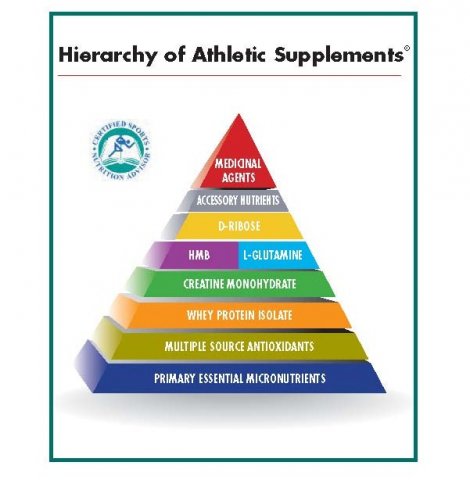You are here
Home ›HMB for Stamina, Strength & Immunity

As outlined in the CHI Hierarchy of Athletic Supplements Pyramid I classify HMB as one of the “Big Four” which also includes whey protein isolate, creatine monohydrate and L-glutamine. In a nutshell, these are the ones that work.
After you’ve created a solid backup of essential micronutrients and multile source antioxidants, determined your daily need for protein and correctly ascertained your requirements and timing for creatine monohydrate, then its time to move forward with glutamine and HMB.
HMB is a water-soluble substance produced in the body from the essential amino acid leucine. As one of the three branched-chain aminos, leucine is incredibly important to muscle physiology and athletic performance. Approximately 3-5 percent of the leucine we consume in dietary protein is converted into HMB, which equates to about 250mg-1000mg per day. Leucine is metabolized and converted into alpha-ketoisocaproate (KIC) which is then oxidized and enzymatically converted into several metabolites, including HMB. This process occurs mainly in the liver and in skeletal muscle. HMB is a natural component of breast milk and is present in small quantities in both plant and animal foods.

Multiple Effects & Athletic Benefits
Based on clinical evidence in several Universities, HMB improves protein metabolism and nitrogen balance in favor of growth. It does this by retarding tissue breakdown and encouraging the build-up of nuclei and proteins in muscle fibers. It also strengthens the immune system by enhancing white blood cell formation which in turn protects organs, glands and functional tissue from the damaging effects of oxidative stress.
HMB is also favored for its effect on adipose tissue (storage fat). When compared to a placebo, controlled study participants get leaner and stronger. HMB seems to improve the metabolism of intramuscular fat (triglycerides) which is important for both endurance and high-intensity training. Although most bodybuilders focus on muscle size & strength, triathletes and runners can elevate their lactate threshold through HMB’s positive effect on increasing maximal oxygen consumption (VO2 peak). HMB is also known to lower total & LDL cholesterol, while raising the HDL fraction.
How does HMB Work?
HMB decreases urinary nitrogen excretion and acts as a “muscle buffer” during high-intensity exercise. One theory suggests that HMB may be converted into special membrane linkage molecules called polymers. These polymers bond to the cell membrane, where they influence nitrogen chemistry and the transport of calcium. HMB is also involved with the synthesis of cholesterol inside muscle cells, which occurs as an adaptive mechanism in response to resistance training. This leads to the formation of natural anabolic hormones, which influence lean tissue growth through the creation of new satellite cells. Higher doses of HMB may also amplify the production of somatomedins (IGF-1) which represent some of the body's most powerful muscle building components.
HMB’s mechanism of action is associated with its effect on muscle damage enzymes, which normally elevate after an intense workout. After HMB supplementation, urine and blood levels of 3-methylhistidine (3-MH) creatine kinase (CK) and lactate dehydrogenase (LDH) are significantly reduced. HMB may also work by modifying the enzymatic response of lysosomes, tiny organelles within the cell. Lysosomal enzymes break down protein molecules and are normally released at the site of an injury to help digest cellular debris. Although this prepares the injured area for repair, over-production of these proteolytic enzymes in the absence of sufficient HMB may impair recovery and growth.
How much HMB should I take and when should I take it?
The general guideline of 3 grams (3000mg) per day of HMB is based on an weight standard of 80kg (175lbs) which is equivalent to about 40mg per kilogram of bodyweight or 18mg per pound. Some strength coaches recommend a loading dose of 100mg per kilo for ten days, followed by a permanent maintenance dose. Others suggest higher quantities (60mg/kg) for short cycles. HMB is more effective when used in conjunction with resistance & endurance training, adequate protein ingestion and creatine monohydrate. It is manufactured under U.S. patent number 5,348,979 and is stabilized as beta-hydroxy beta-methylbutyrate monohydrate.
CHI HMB Dosage Guideline Chart
Recognized as one of the world’s leading experts on HMB biochemistry, Dr. Steve Nissen, Ph.D. recommends spreading out your daily dose as much as possible throughout the day. A double dose two hours before exercise will help maximize muscle and strength gains by inhibiting protein breakdown. HMB can be taken on an empty stomach or with a meal. It’s safe for everyone as extensive safety profiles have discovered no adverse effects on tissue cells, kidney and liver function, blood and brain chemistry.
HMB is of particular value to those who want to get leaner and stronger or enhance their training stamina. It’s also excellent for improving immune status and guarding tissue from damage caused by free radical pathology & oxidative stress. HMB is to the ectomorph (hard-gainer) what ephedrine is to the endomorph (gains fat easily). If you’re skinny and can’t gain weight, combine intense resistance training with sufficient high- quality protein, phosphatidylserine (PS), magnesium, niacinamide (B3) omega-3s and HMB. And if you think your self-confidence will go up with an extra 10-20 lb. of natural muscle, guess what?…you’re right!

As always, stay well and live free!
Dr.C
- Log in to post comments